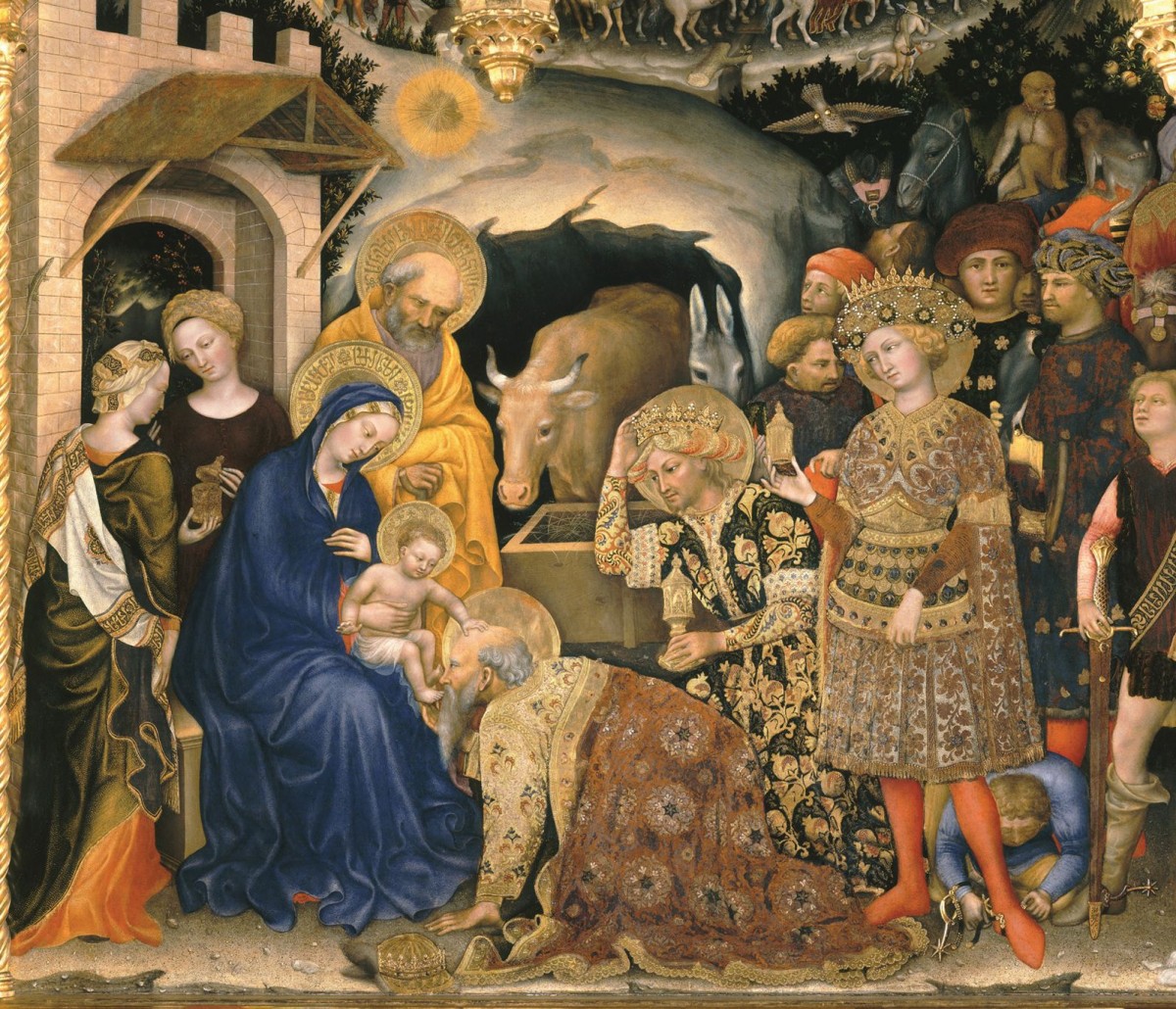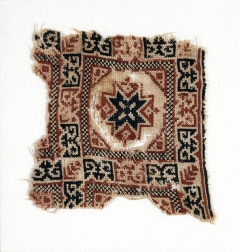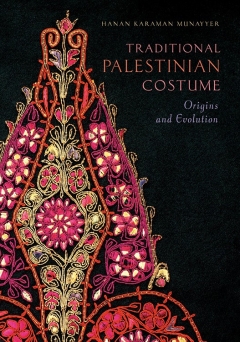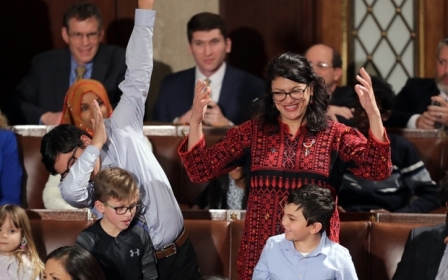Palestinian fashion from ancient Canaan to a thobe in Congress
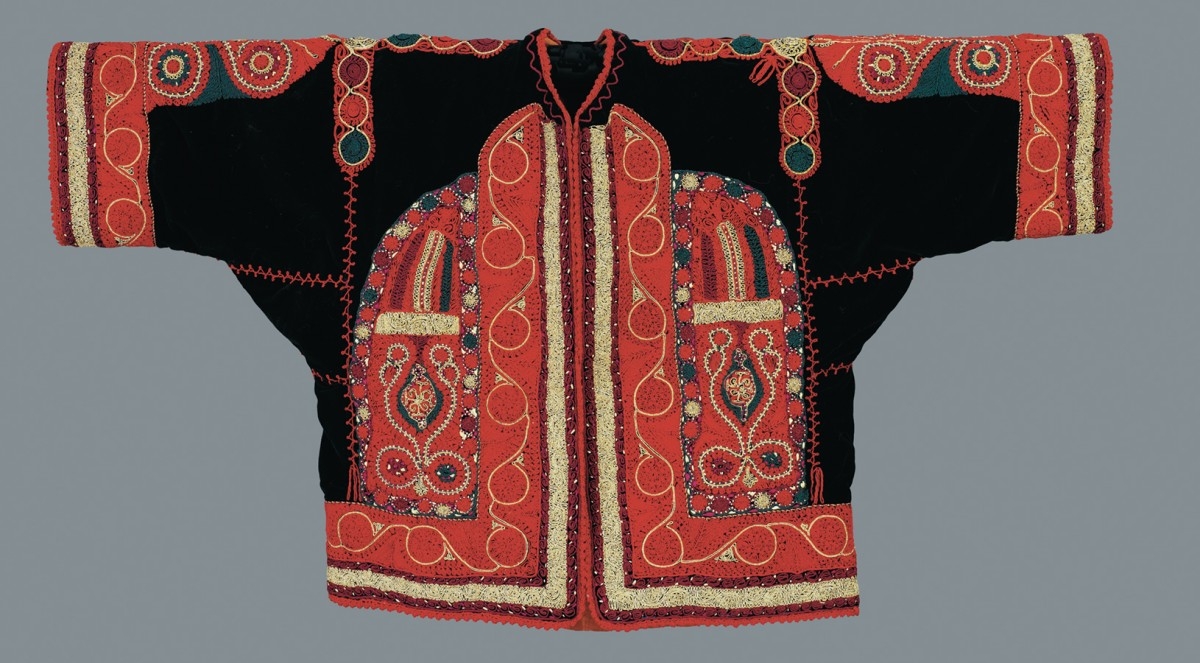
For decades the embroidery so common in traditional Palestinian fashion, known in Arabic as tatreez, has been a unifying symbol for Palestinians in the post-1948 diaspora, a fact evidenced by the reaction to US Congresswoman Rashida Tlaib’s decision, in January 2019, to wear a thobe (traditional Palestinian dress) to her congressional swearing-in ceremony.
In the weeks before that event, Tlaib posted a photo of a hand-stitched thobe on Instagram, announcing that she would be wearing it to the ceremony.
Worried by the anti-Muslim and anti-Arab backlash that was triggered by her post, and deeply moved by her pride in her Palestinian heritage, I launched a hashtag, #tweetyourthobe, to spotlight Tlaib’s powerful nod to Palestinian identity.
By the time Tlaib took her oath on the Quran, hundreds of photos of women in thobes using the hashtag had flooded Twitter.
Tlaib herself tweeted, “So loved all the amazing women from across the country and world who shared their gorgeous Palestinian thobes. We inspired so many. This historic moment belongs to all of us.”
This three-day online Palestinian fashion show left journalists to grapple with questions about the significance of this particular type of costume. Their questions ranged from “What is a thobe?” to “What is the history of tatreez?”
In March this year, a new book by the co-founder and president of the Palestinian Heritage Foundation, Hanan Karaman Munnayer, answered those very questions.
Traditional Palestinian Costume: Origins and Evolution is a stunning, 560-page volume, in which Munayyer - who has researched and lectured on Palestinian textile arts for more than 20 years - painstakingly documents the history and intricacies of Palestinian fashion, specifically the legacy of tatreez.
Perusing the volume is akin to strolling through a museum, as page after page displays vivid and colourful photos of Palestinian thobes, headdresses, and jewellery - some dating back to ancient times.
The reader will view samples of artwork from before the time of Christ that depict the distinct clothing styles of the region, as well as photographs featuring nearly threadbare examples of tatreez taken from textiles that are decades old.
'The Other's myth'
In the foreword by Hanan Ashrawi, the revered Palestinian stateswoman, scholar, and activist, calls the book proof that "Palestine was never a land without a people". In fact, Munayyer dives deep into the historical record to demonstrate the baselessness of that particular piece of propaganda - what Ashrawi calls “the Other’s myth”.
As early as 1200 BCE, a distinct mode of embroidery, patterns, and fashion can be linked to the Palestinian region, known then as Canaan. Ancient artwork, from ivory engravings to painted tiles, depict Canaanites wearing clothing distinct from other neighbouring cultures, such as Syrians and Nubians.
In fact, explains Munayyer, Canaanites were renowned for their unique textiles: “Canaan” means “Land of Purple” because of the precious, sought-after purple dye obtained from murex sea snails and used to colour their fabrics.
The very cut of Palestinian dresses bears significance, as “the cut of a traditional costume is an important indication of its historical origins”. The Palestinian robe, unchanged in its form for centuries, consists of several pieces - front and back panels, bands for the edge, a “square or rectangular chestpiece,” and sleeves - that can be traced back to similar garments produced in the region during the second century BCE.
Post-Crusades, styles common in Palestine crept into European fashion. Several works of art depict European models wearing garments edged with couched embroidery or Arabic-script calligraphy.
In one especially fascinating section, Munayyer discusses the influence of the Palestinian region on headdresses worn by medieval European women.
The hennin, also known as the “steeple headdress”, will be familiar to many people - it was a conical cap to which gauzy veils are attached, and the favoured headdress of wealthy women.
That fashion was adopted from the Levantine tantour after the Crusades. In fact, Munayyer documents one source that refers to the hennin as the “bonnet a la syrienne”.
Another European headdress style, a short cap worn by women, is actually modelled after a traditional Bethlehem style: “The headdress of Bethlehem, called shatweh, goes back to antiquity,” explains Munayyer. Shaped like a tarboush, or fez, the shatweh was often decorated with coins or precious stones.
Symbolic stitches
While tracing styles back through antiquity and the medieval era is fascinating, Munayyer’s exploration of Palestinian embroidery patterns and symbols is especially compelling because it contributes to current research.
The trade between the Arab world and Europe usually passed through Italy... and patterns found on European garments can be traced directly to Palestine
The history of tatreez is a burgeoning subject of study due to the efforts, in recent years, to preserve Palestinian culture in the face of colonial efforts to erase it.
In fact, two of the most interesting books on this subject are Leila al-Khalidi’s The Art of Palestinian Embroidery (1999), an encyclopaedia-like text of motifs that appear in Palestinian tatreez, and Shelagh Weir and Serene Shahid’s Palestinian Embroidery (2007) - both of which document the art’s history and offer colourful examples of embroidered textiles.
Another excellent book is Tatreez & Tea (2018), a hybrid memoir, history and workbook by Wafa Ghnaim, a tatreez artist and scholar who learned the skill from her own mother. Ghnaim offers popular classes and seminars in the art form across the US, but especially in the New York - Washington DC corridor, exploring the language of tatreez.
Traditional Palestinian Costume adds to the field significantly, by documenting not only some of the most familiar embroidery motifs, but also tracing their existence through centuries and across continents. The trade between the Arab world and Europe usually passed through Italy, especially Venice, says Munayyer, and patterns found on European garments can be traced directly to Palestine.
The eight-pointed star, for example, has been stitched on Palestinian garments and home textiles for centuries: “The ubiquitous and ancient eight-pointed star pattern,” she writes, “[has been] found in the Middle East on stone, metal, and wood-work in many crafts since antiquity.” (The star, still a popular symbol, featured prominently in red thread on the thobe worn by Congresswoman Tlaib.)
The star is a motif that was copied and reproduced on textiles in Europe, where it was referred to as the “Holy Star of Bethlehem”, lending further evidence to its Palestinian cultural origins.
Other motifs that travelled widely include various bird patterns, especially the pattern of two birds facing one another, and the S-motif, which is referred to as the alaqa, the Arabic word for leech. The leech was a prominent symbol given its use to heal the sick in ancient medicine, and this shape is still popular on Palestinian textiles.
The final section offers a glimpse of the ways in which modern women continue the tradition of tatreez and the ways in which much of it is now produced by women in workshops, in an attempt to financially provide for their families.
Many organisations have taken advantage of the popular interest in tatreez to employ Palestinian women in producing these textiles for sale.
An art that symbolises family bonds- as tatreez was a skill passed down, much like the thobes themselves, from mothers to daughters - now serves as a means for family survival for women in occupied Palestine, refugee camps and the wider diaspora.
After the Nakba in 1948, many Palestinians became refugees and women sold their precious dresses in order to survive; this is the manner by which many thobes were purchased by collectors.
Munayyer explains how she and her husband amassed their own vast collection and explains the contributions to it by other advocates of Palestinian artwork.
Labour of love
Books produced with full-colour photos are quite expensive, and at $100 a copy this one doesn't come cheap. But in the case of Munayyer’s tome (which features hundreds of colour photographs), the publishers say they were not motivated by profit but by a wish to solidify the historical records available about Palestinian culture and history.
“This book is a labour of love (we do not expect to cover our production costs even if we sell out of our entire print run),” writes Interlink’s founder and publisher, Michel Moushabeck.
In this way, Moushabeck states, it “represents nonviolent resistance at its best”. In fact, with every order of the book through the end of June 2020, Interlink will pay to have an olive tree planted in Palestine through the Trees for Life programme, via Zaytoun, an organisation that provides sustainable income for Palestinian farmers.
This gesture of solidarity is tied deeply into the mission of the book itself: the preservation of the Palestinian people’s way of life and culture.
More than the historical documentation and the importance of tracing Palestinian culture back across centuries, Traditional Palestinian Costume is a project of resistance in itself and quite simply a feast for the eyes.
The quality of the photographs and the vibrant colours make it difficult to put down. It is a book to keep close to hand, proof of the beauty and artistry of Palestinian women, from Ramallah to the Galilee, to al-Khalil, to Gaza.
Traditional Palestinian Costume: Origins and Evolution, by Hanan Karaman Munayyer, is available from Interlink Publishing.
Middle East Eye propose une couverture et une analyse indépendantes et incomparables du Moyen-Orient, de l’Afrique du Nord et d’autres régions du monde. Pour en savoir plus sur la reprise de ce contenu et les frais qui s’appliquent, veuillez remplir ce formulaire [en anglais]. Pour en savoir plus sur MEE, cliquez ici [en anglais].




